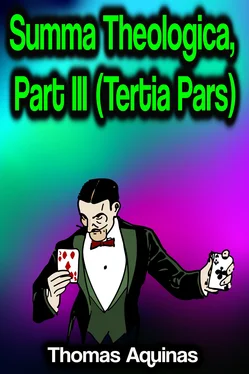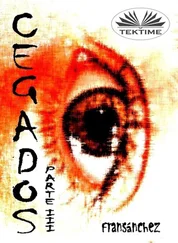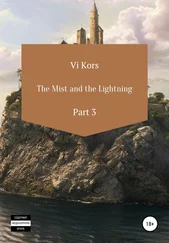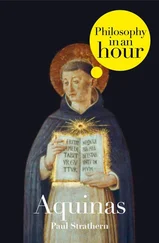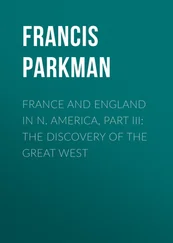Reply Obj. 2: The generative power of the female is imperfect compared to that of the male. And, therefore, just as in the arts the inferior art gives a disposition to the matter to which the higher art gives the form, as is stated Phys. ii, so also the generative power of the female prepares the matter, which is then fashioned by the active power of the male.
Reply Obj. 3: In order for a transformation to be natural, there is no need for an active principle in matter, but only for a passive principle, as stated above.
Question 33. Of The Mode And Order Of Christ's Conception (In Four Articles)
We have now to consider the mode and order of Christ's conception, concerning which there are four points of inquiry:
(1) Whether Christ's body was formed in the first instant of its conception?
(2) Whether it was animated in the first instant of its conception?
(3) Whether it was assumed by the Word in the first instant of its conception?
(4) Whether this conception was natural or miraculous? _______________________
FIRST ARTICLE [III, Q. 33, Art. 1]
Whether Christ's Body Was Formed in the First Instant of Its
Conception?
Objection 1: It would seem that Christ's body was not formed in the first instant of its conception. For it is written (John 2:20): "Six-and-forty years was this Temple in building"; on which words Augustine comments as follows (De Trin. iv): "This number applies manifestly to the perfection of our Lord's body." He says, further (QQ. lxxxiii, qu. 56): "It is not without reason that the Temple, which was a type of His body, is said to have been forty-six years in building: so that as many years as it took to build the Temple, in so many days was our Lord's body perfected." Therefore Christ's body was not perfectly formed in the first instant of its conception.
Obj. 2: Further, there was need of local movement for the formation of Christ's body in order that the purest blood of the Virgin's body might be brought where generation might aptly take place. Now, no body can be moved locally in an instant: since the time taken in movement is divided according to the division of the thing moved, as is proved Phys. vi. Therefore Christ's body was not formed in an instant.
Obj. 3: Further, Christ's body was formed of the purest blood of the Virgin, as stated above (Q. 31, A. 5). But that matter could not be in the same instant both blood and flesh, because thus matter would have been at the same time the subject of two forms. Therefore the last instant in which it was blood was distinct from the first instant in which it was flesh. But between any two instants there is an interval of time. Therefore Christ's body was not formed in an instant, but during a space of time.
Obj. 4: Further, as the augmentative power requires a fixed time for its act, so also does the generative power: for both are natural powers belonging to the vegetative soul. But Christ's body took a fixed time to grow, like the bodies of other men: for it is written (Luke 2:52) that He "advanced in wisdom and age." Therefore it seems for the same reason that the formation of His body, since that, too, belongs to the generative power, was not instantaneous, but took a fixed time, like the bodies of other men.
On the contrary, Gregory says (Moral. xviii): "As soon as the angel announced it, as soon as the Spirit came down, the Word was in the womb, within the womb the Word was made flesh."
I answer that, In the conception of Christ's body three points may be considered: first, the local movement of the blood to the place of generation; secondly, the formation of the body from that matter; thirdly, the development whereby it was brought to perfection of quantity. Of these, the second is the conception itself; the first is a preamble; the third, a result of the conception.
Now, the first could not be instantaneous: since this would be contrary to the very nature of the local movement of any body whatever, the parts of which come into a place successively. The third also requires a succession of time: both because there is no increase without local movement, and because increase is effected by the power of the soul already informing the body, the operation of which power is subject to time.
But the body's very formation, in which conception principally consists, was instantaneous, for two reasons. First, because of the infinite power of the agent, viz. the Holy Ghost, by whom Christ's body was formed, as stated above (Q. 32, A. 1). For the greater the power of an agent, the more quickly can it dispose matter; and, consequently, an agent of infinite power can dispose matter instantaneously to its due form. Secondly, on the part of the Person of the Son, whose body was being formed. For it was unbecoming that He should take to Himself a body as yet unformed. While, if the conception had been going on for any time before the perfect formation of the body, the whole conception could not be attributed to the Son of God, since it is not attributed to Him except by reason of the assumption of that body. Therefore in the first instant in which the various parts of the matter were united together in the place of generation, Christ's body was both perfectly formed and assumed. And thus is the Son of God said to have been conceived; nor could it be said otherwise.
Reply Obj. 1: Neither quotation from Augustine refers to formation alone of Christ's body, but to its formation, together with a fixed development up to the time of His birth. Wherefore in the aforesaid number are foreshadowed the number of months during which Christ was in the Virgin's womb.
Reply Obj. 2: This local movement is not comprised within the conception itself, but is a preamble thereto.
Reply Obj. 3: It is not possible to fix the last instant in which that matter was blood: but it is possible to fix the last period of time which continued without any interval up to the first instant in which Christ's body was formed. And this instant was the terminus of the time occupied by the local movement of the matter towards the place of generation.
Reply Obj. 4: Increase is caused by the augmentative power of that which is the subject of increase: but the formation of the body is caused by the generative power, not of that which is generated, but of the father generating from seed, in which the formative power derived from the father's soul has its operation. But Christ's body was not formed by the seed of man, as stated above (Q. 31, A. 5, ad 3), but by the operation of the Holy Ghost. Therefore the formation thereof should be such as to be worthy of the Holy Ghost. But the development of Christ's body was the effect of the augmentative power in Christ's soul: and since this was of the same species as ours, it behooved His body to develop in the same way as the bodies of other men, so as to prove the reality of His human nature. _______________________
SECOND ARTICLE [III, Q. 33, Art. 2]
Whether Christ's Body Was Animated in the First Instant of Its
Conception?
Objection 1: It would seem that Christ's body was not animated in the first instant of its conception. For Pope Leo says (Ep. ad Julian.): "Christ's flesh was not of another nature than ours: nor was the beginning of His animation different from that of other men." But the soul is not infused into other men at the first instant of their conception. Therefore neither should Christ's soul have been infused into His body in the first instant of its conception.
Obj. 2: Further, the soul, like any natural form, requires determinate quantity in its matter. But in the first instant of its conception Christ's body was not of the same quantity as the bodies of other men when they are animated: otherwise, if afterwards its development had been continuous, either its birth would have occurred sooner, or at the time of birth He would have been a bigger child than others. The former alternative is contrary to what Augustine says (De Trin. iv), where he proves that Christ was in the Virgin's womb for the space of nine months: while the latter is contrary to what Pope Leo says (Serm. iv in Epiph.): "They found the child Jesus nowise differing from the generality of infants." Therefore Christ's body was not animated in the first instant of its conception.
Читать дальше
